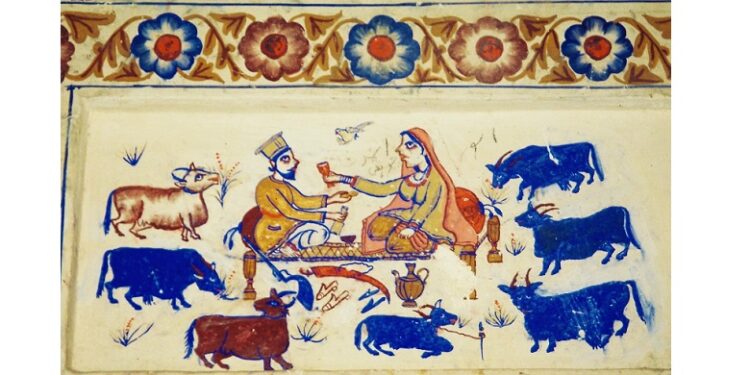
We find them depicted in five common types of scenes in Kalhora and Talpur era tombs.
Zulfiqar Ali Kalhoro
Like many other folk romances, the folktale of Suhni and Mehar also captured the attention of Sindhi painters, who painted the story on the walls of tombs located in various districts of Sindh. The following five episodes from the story of Suhni and Mehar are depicted in the Sindhi tombs that exist in several districts of Sindh:
- Suhni’s crossing the river to meet her beloved Mehar
- An initial meeting of Suhni and Mehar
- Suhni making lassi (a beverage made from curd) for her beloved Mehar
- Mehar grazing the buffaloes
- A representation of the shrine of Suhni-Mehar
These representations, in particular, can be seen in the Jamali tombs in Shahdadkot, the Mian Nasir Muhammad Kalhoro tombs near Garhi, the Mir Allayar tombs at Drigh Bala, the Muridani Jamali tombs near Phulji, the Rodhnani tombs at Thull, the Shahani tombs at Chhini in Dadu, the Abra tombs in Nawabshah and the Marri tombs in Sanghar.
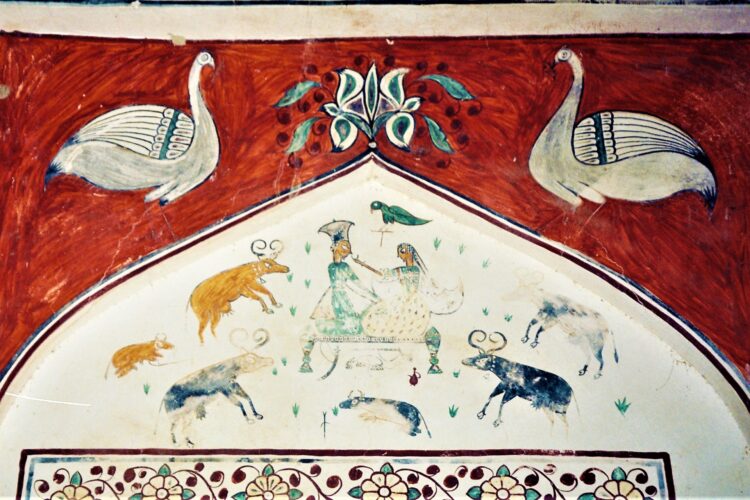
The earliest representations of Suhni and Mehar are found in the tombs of Mian Nasir Muhammad Kalhoro. Suhni-Mehar painting appeared later in several other tombs that were erected during the Kalhora and Talpur periods and even during the British Raj. The earliest depiction in which Suhni is shown crossing the river is found in the tomb of Mir Allahyar Khan Talpur, which was erected during the reign of Mian Noor Muhammad Kalhoro (1719-1753). The tomb of Mir Allahyar Khan Talpur is located about 3 km west of Drigh Bala on the left bank of Nai Gaj in Johi taluka, Dadu. On the western wall of Mir Allahyar Khan Talpur’s tomb is a large panel depicting battle scenes and the folk romance of Suhni and Mehar. There are two small panels along with a large panel. The first panel shows Suhni in the middle of the river and she is surrounded by fish and a crocodile. She is depicted as gently touching the crocodile and it does not appear to be ferocious. On the riverbank, a saintly figure is shown praying for a safe crossing by Suhni. Close to this is the second panel which shows both Suhni and Mehar surrounded by buffaloes. In this depiction, both are shown standing and talking with each other. Suhni is depicted holding a bowl (possibly containing lassi) for her beloved, which she is offering to him. These two panels are the earliest ones in the necropolis of Mir Allahyar Khan Talpur. The figures of both Suhni and Mehar themselves have long, pointed noses and almond-shaped eyes.
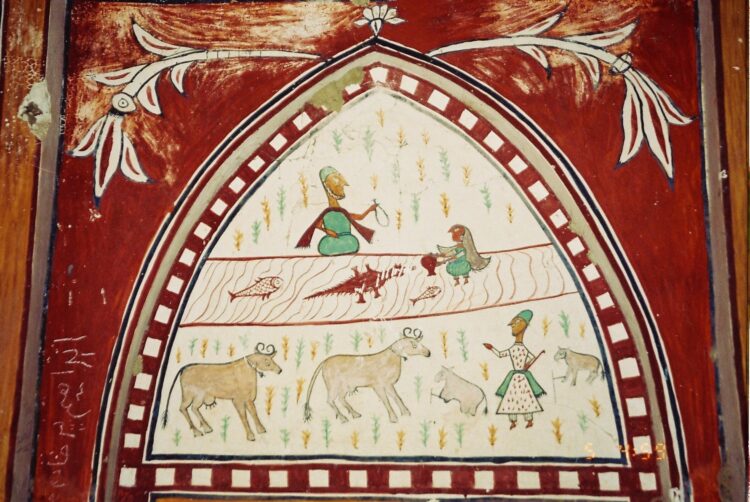
Apart from Mir Allahyar Khan Talpur’s mausoleum, the tomb of Shadman Laghari at Murid Dero, Johi, also depicts the romance of Suhni and Mehar. Within the arched recess on the western wall of the tomb is a painting of Suhni and Mehar. This is quite an interesting representation as Suhni is shown seeking the blessings of a saint, before entering and crossing the river to meet her beloved Mehar, who is depicted as grazing the buffaloes on the other side of the riverbank. Interestingly, there is the figure of a rider close behind the painting of Suhni and it appears to be that of her fiancé, Dum, who is shown to be chasing her. This is possibly the only representation of Suhni and Mehar romance in which Suhni’s fiancé, Dum, is also shown. Again, the distinctive feature of the painting is the long, pointed noses of the figures. The colours of the painting have faded due to their exposure to rainwater and sunlight. The dome of the tomb has caved in, thereby exposing the murals to sunlight. On the other hand, a saint – or perhaps mystical figure Khawaja Khizr – is depicted in the representation of the Suhni and Mehar romance in the tomb of Shadman Laghari. Khwaja Khizr is the saint associated with water, who protects his devotees from trouble, dilemma, and misfortune.
Apart from the paintings in the tombs of the Laghari tribe, one finds some refined representations of the Suhni and Mehar romance in the Muridani Jamali tombs, which are located 5 km west of Hairo Khan village. There are three tombs in the necropolis that represent the romance of Suhni and Mehar as well as that of Sausi and Punhun. One of the panels in a Muridani Jamali necropolis shows Suhni and Mehar on the cot and on either side of it are the figures of buffaloes.
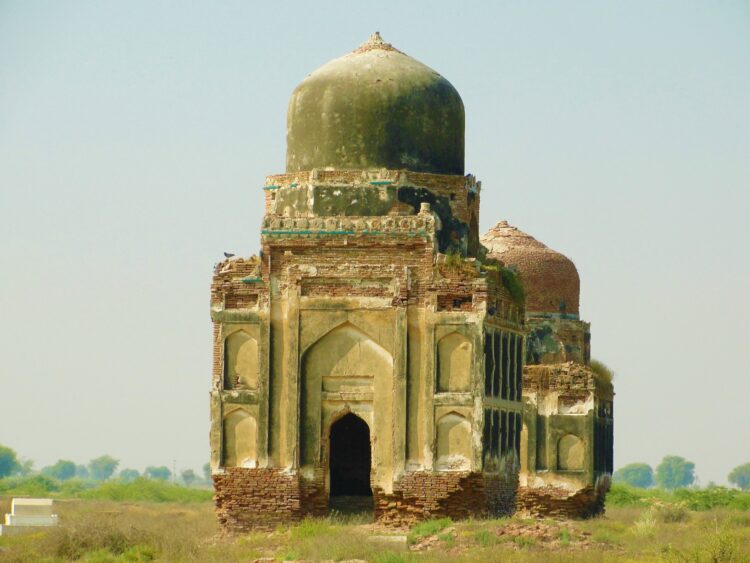
Another tomb in the necropolis of the Muridani Jamalis depicts the Suhni and Mehar romance. There is a single panel that bears Suhni crossing the river to meet her beloved Mehar. As seen in several similar depictions, Mehar is shown grazing the buffaloes on the riverbank. Interestingly enough, the saintly figure as seen in several other depictions is missing. Suhni is surrounded by fish and a crocodile that appears to devour her clay pot. This is meant to show that Suhni is in trouble and that is why one does not find the saintly figure which is depicted praying for Suhni’s safe journey across the wild river. In this depiction, both Suhni and Mehar are depicted in red dress.
Another nearby tomb also depicts Suhni and Mehar. Both are shown sitting on the cot and surrounded by buffaloes. Mehar’s sword and gun (lying under the cot) are visible in this representation. Above both figures are pictures of parrots. It is to be noted that the parrot is a symbol of love when used in these rural folk paintings.
Located about 8 km south of the Muridani Jamali tombs are the mausoleums of the Qalandarani Lagharis. There are six tombs of which one depicts Suhni and Mehar in romantic postures. Suhni is depicted as crossing the river and, in this depiction, a saintly figure – likely Khwaja Khizr – is added. The saintly figure or Khwaja Khizr is holding a rosary in his hand and he is depicted as wearing a green-colored dress. Suhni is also dressed in green, whereas Mehar is dressed in white, and he is wearing a green cap and belt around his waist. Another noteworthy thing is that the buffaloes are painted grey – when compared to earlier representations in which they were in black and brown in colors.
In some depictions of the romance of Suhni and Mehar, a saintly person/ Khwaja Khizr is present while in others the figure is absent. There is a Suhni and Mehar depiction in one of the Abra tombs at Muhammad Khan Vighio village in the Nawabshah district in which the saintly figure is also absent. However, Suhni is shown crossing the river and the buffaloes found on both banks are also shown swimming across the river.
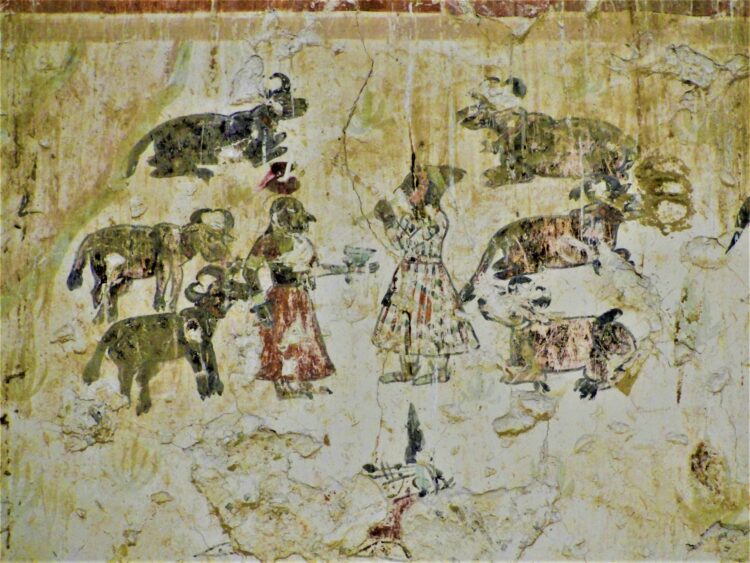
The tomb of Sultan Marri at the Tilla Shah necropolis in the district of Sanghar displays a similar painting of Suhni and Mehar. In this depiction the saintly figure which is likely to be Khwaja Khizr is again present, and he is shown as riding on top of fish. The figure appears very clear and defined in this depiction, with a pair of fish swimming under his feet. Furthermore, he is depicted as reciting from the Holy Book. The earlier representations showed him sitting under a tree facing the river and holding a rosary, with no clear indication of any fish as his vehicle or mount. He is depicted in a green dress with a white turban and standing in front of the bearded figure of Khwaja Khizr are his green walking stick and a water flask. On the other side of the river along the bank, Mehar is shown seated under a tree playing the flute and he is depicted as wearing a yellow-colored dress. In the middle of the river is the figure of Suhni surrounded by fish, crocodiles and buffaloes. Unfortunately, this painting has been damaged by rainwater that has seeped in from cracks in the dome. Due to this seepage, sludge has tainted the figures of Khwaja Khizr and Mehar. This particular depiction of the Suhni and Mehar romance persistently appears in several tombs in the Dadu district. Close to this panel, there is another depiction which is probably of Bahram Gur and Dilaram.
Apart from these two episodes from the story of Suhni and Mehar, there is another episode that often appears in the tombs. This episode shows Suhni preparing lassi for her beloved Mehar. In some of the tombs, she is shown churning the milk while Mehar is milking the buffaloes.
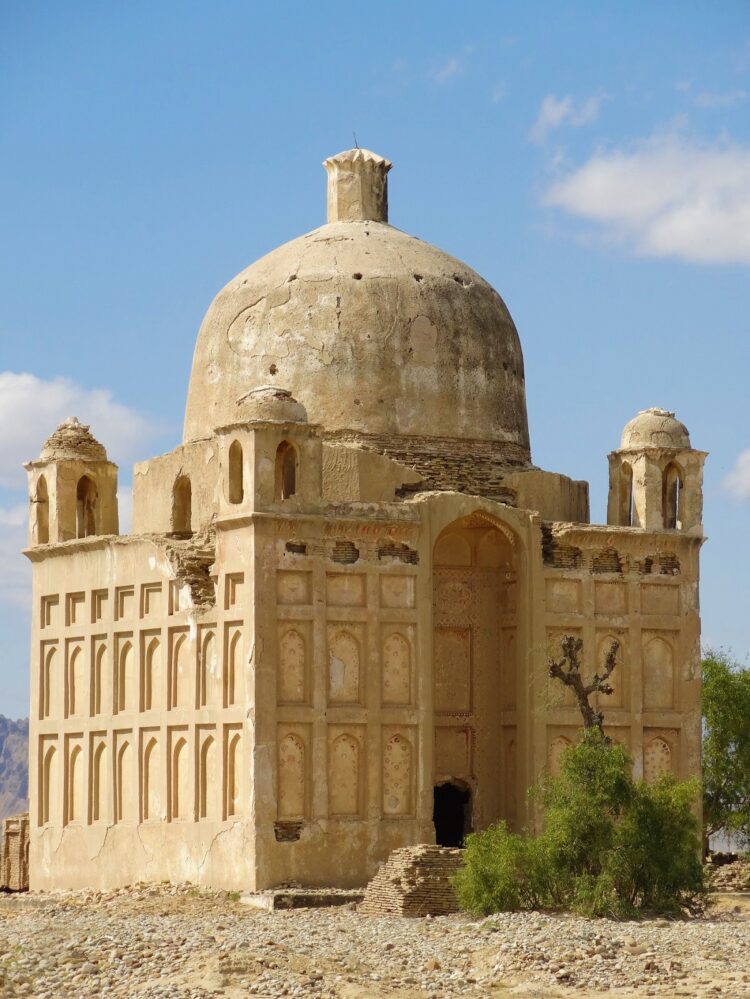
The tomb of Ghazi Khan near Gebi Dero depicts Suhni churning milk while Mehar is busy milking buffaloes. The parrot, the symbol of love, is depicted wherever Suhni is represented. This lovebird is shown sitting on top of the churning stick. A similar scene of Suhni preparing lassi for her beloved Mehar is found in the tomb of Mir Muhammad Khan Chandio at Rais Bambho Khan Village. There is a single panel in which three stories have been depicted. At the top is a depiction of the romance of Sasui and Punhun, on the left is a painting showing paddy-cultivation activity and on the right is a depiction of Suhni and Mehar. She is depicted as churning milk and behind her is the figure of Mehar seated on a cot. Buffaloes are also shown in front of the figure of Suhni. A calf is tethered to a peg while the parent buffalo is standing close to its calf. The parrot is again shown seated atop the churning stick.
Another episode from the story is the representation of Mehar as a buffalo-herder. He is shown grazing the buffaloes and playing the flute. This painting is found in a few tombs in the Larkana and Dadu districts. In the tomb of Mir Muhammad Khan Chandio, one finds the painting of Mehar in which he is shown as grazing buffaloes and playing the flute. Above him is the painting of a hunter who is hunting deer. A few depictions of Mehar as a buffalo-herder are also found in the tombs of Mian Nasir Muhammad Kalhoro.
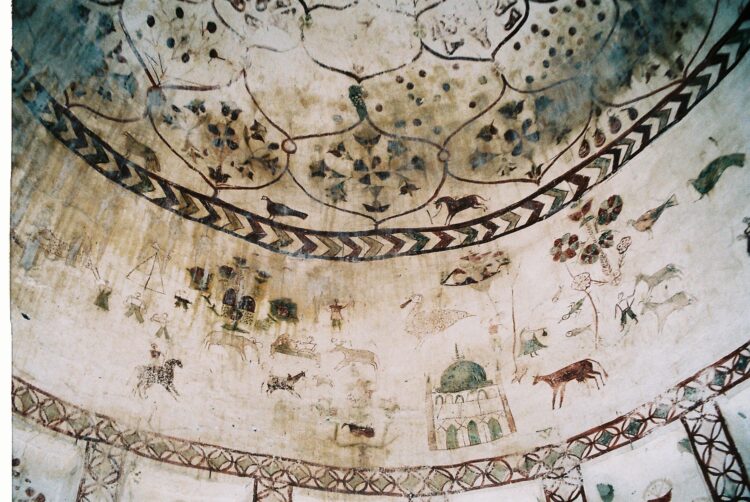
The last episode of the Suhni and Mehar story is also painted in some tombs. This final episode shows the death of both Suhni and Mehar, after both drowned in the river, with their ultimate union taking place in their simultaneous death. The painters have depicted the final episode of the story in the form of the shrine of Suhni and Mehar. There is a large panel depicting three episodes of the Suhni and Mehar romance in the tomb of Lahno Khan at Rais Bambho Khan in the district of Kamber-Shahdadkot. The first episode shows Suhni crossing the river and the second shows the meeting of the two lovers who are depicted as sitting on a cot with buffaloes surrounding them. The third episode has the ‘shrine’ belonging to Suhni and Mehar that shows Suhni as screaming and drowning while Mehar, on hearing the screams of his beloved, jumps into the river in an attempt to save her but, in the end, both were drowned. The painter depicted the final episode by painting their tomb/shrine as a representation indicating that they both died but were united in death. The tomb of Lahno Khan was built during the last days of the Kalhora dynasty or at the beginning of the Talpur dynasty. There are two graves in the tomb, belonging to Lahno Khan and Tharo Khan respectively. The depiction of a shrine of Suhni and Mehar is only peculiar to the tomb of Lahno Khan and is not found in any other mausoleum in Sindh. As discussed above, the Suhni and Mehar ‘shrine’ has been painted between the two different episodes of the romance. On the left of the shrine is a depiction of Suhni and Mehar seated on a cot that is surrounded by buffaloes. On the right is a representation of Suhni crossing the river to meet her beloved Mehar. In between these two depictions is the representation of Suhni and Mehar’s shrine with buffaloes standing on the right side, in a submissive posture.
The Sindhi tombs depict folk romances of not only Suhni and Mehar but also those of Sasui and Punhun, Leela and Chanesar, Laila and Majnun, Moomal and Rano, Umar and Marvi and Nuri and Jam Tamachi. However, the mural paintings of the folk tale associated with Suhni and Mehar are a distinctly common visual feature in every ‘nook and corner’ of Sindh wherever the Kalhora and Talpur period tombs are located. This reflects the liberal attitude held by the rulers who patronized the art of creating mural paintings.
___________________
The writer is an anthropologist. He tweets at: @Kalhorozulfiqar. All photos by the author
The author has shared this article with Sindh Courier, which originally was published by The Friday Times Lahore.